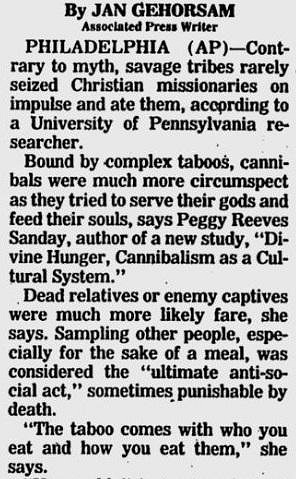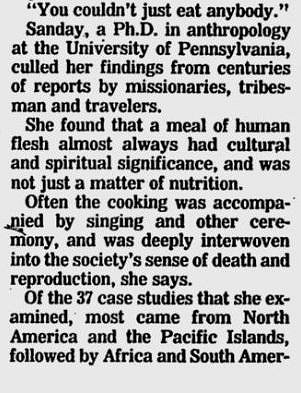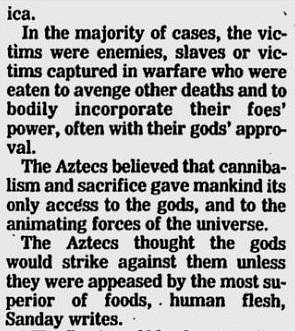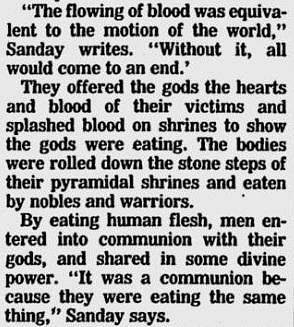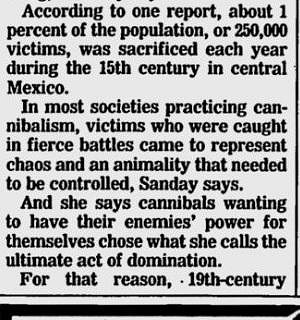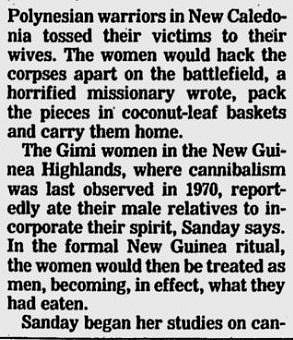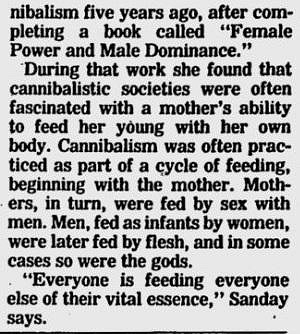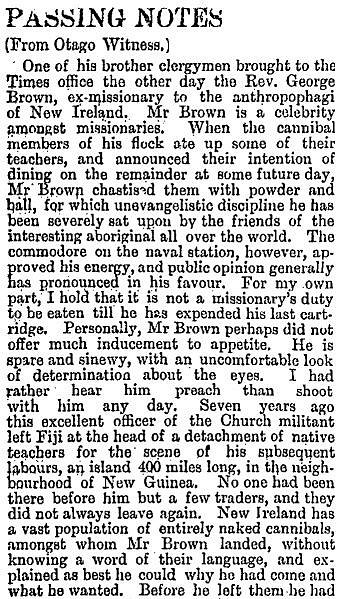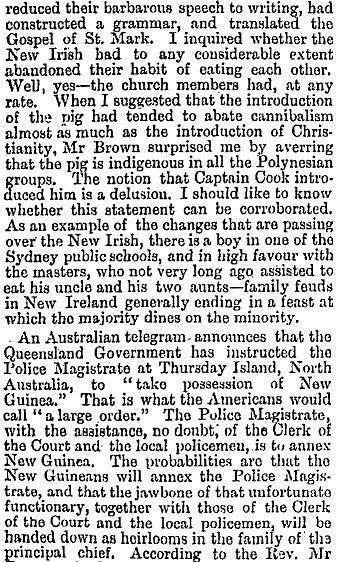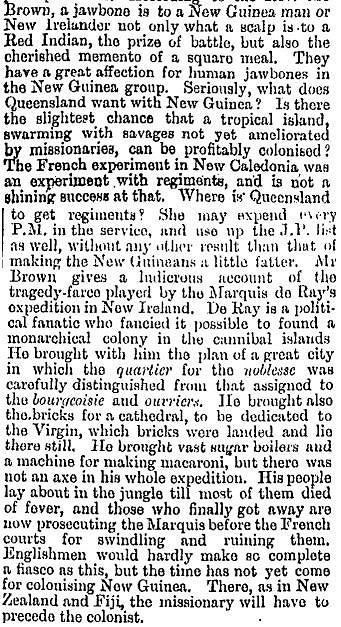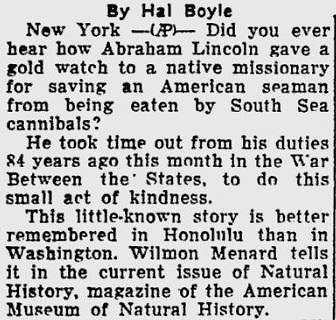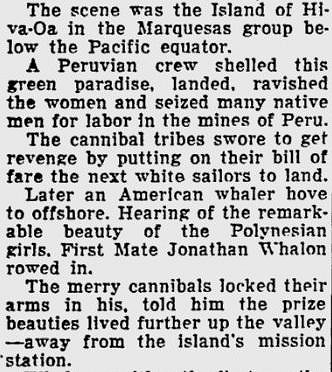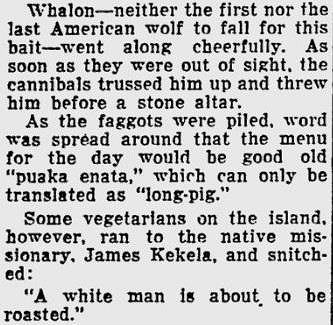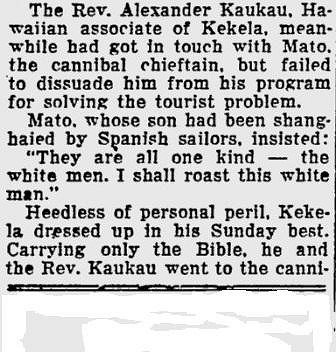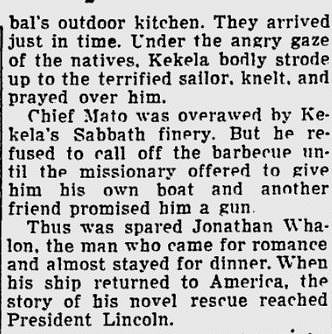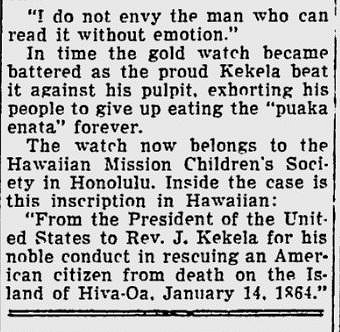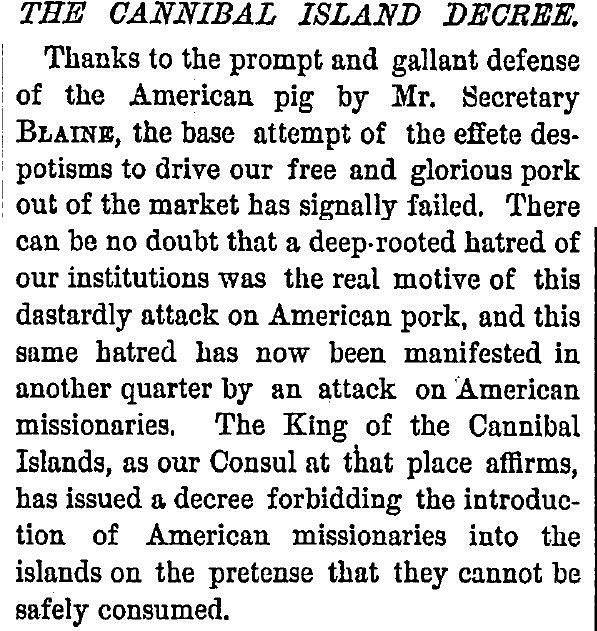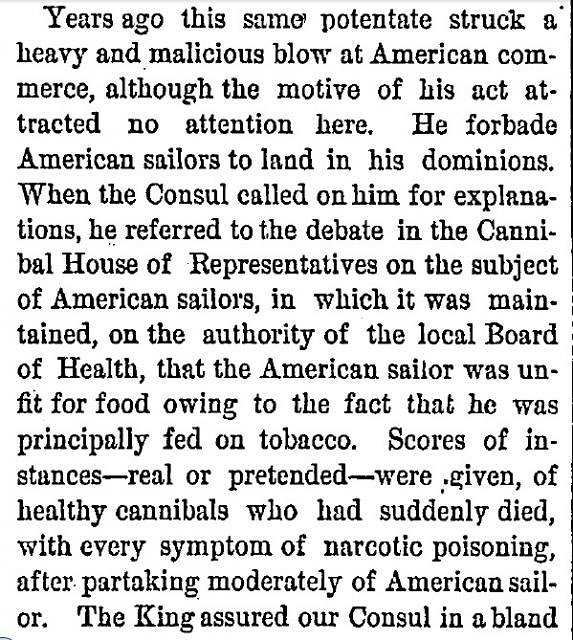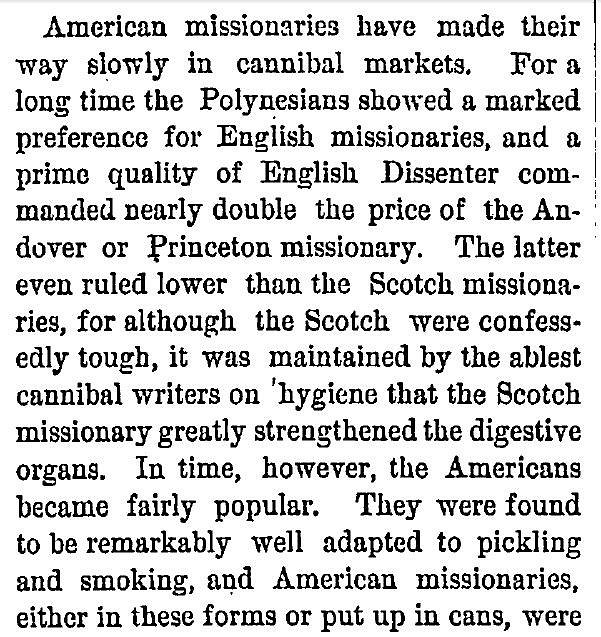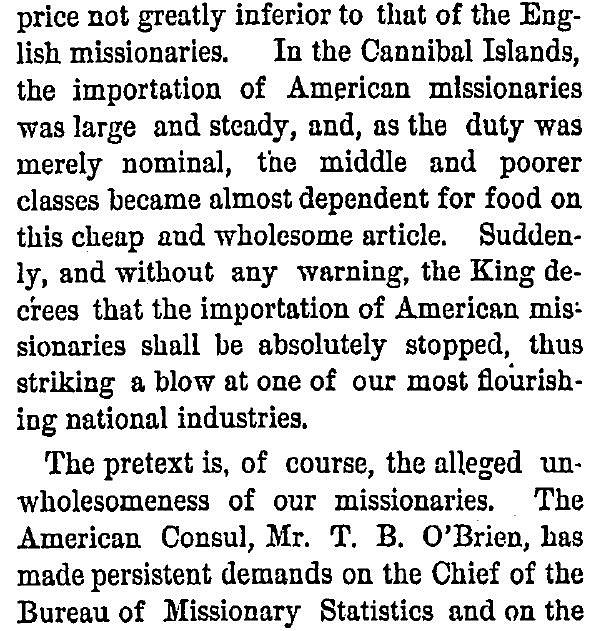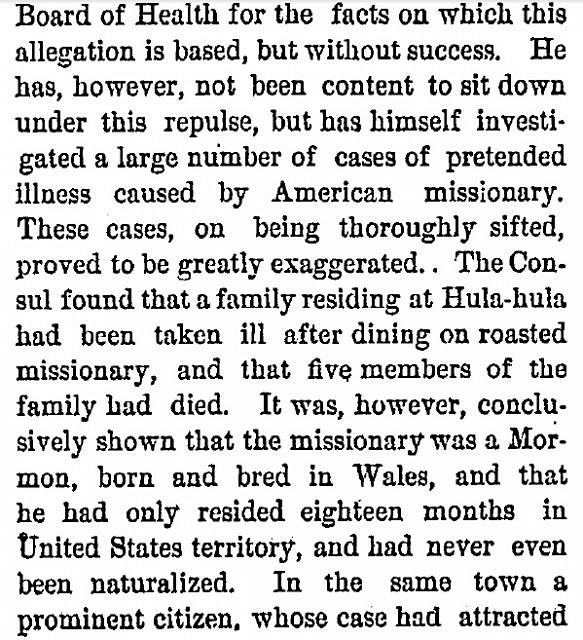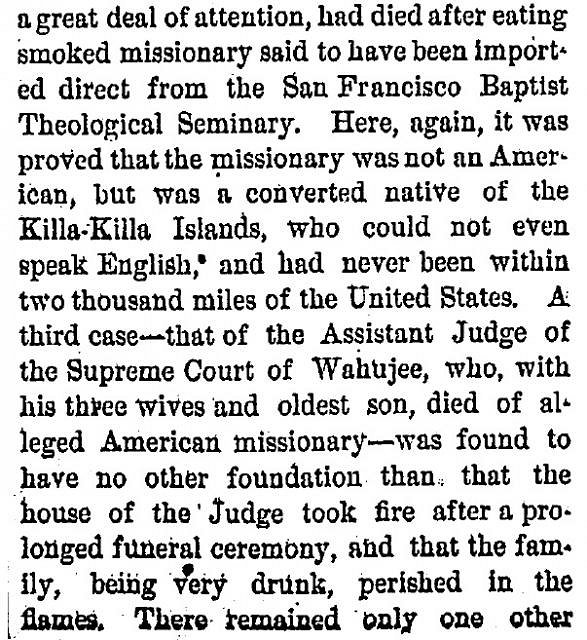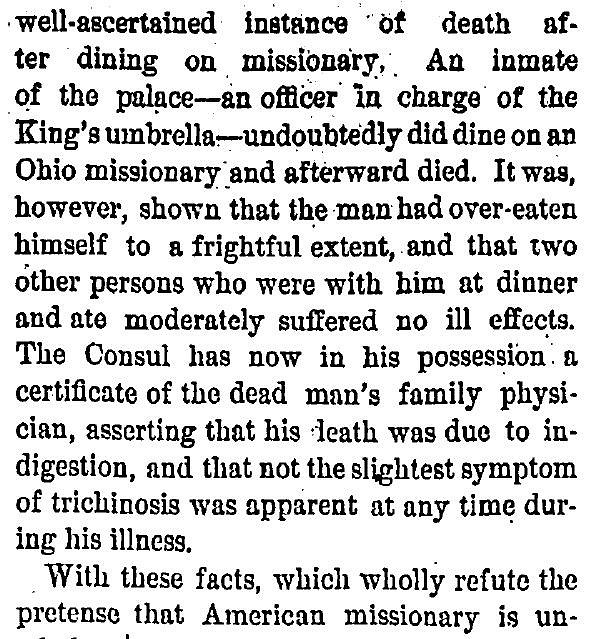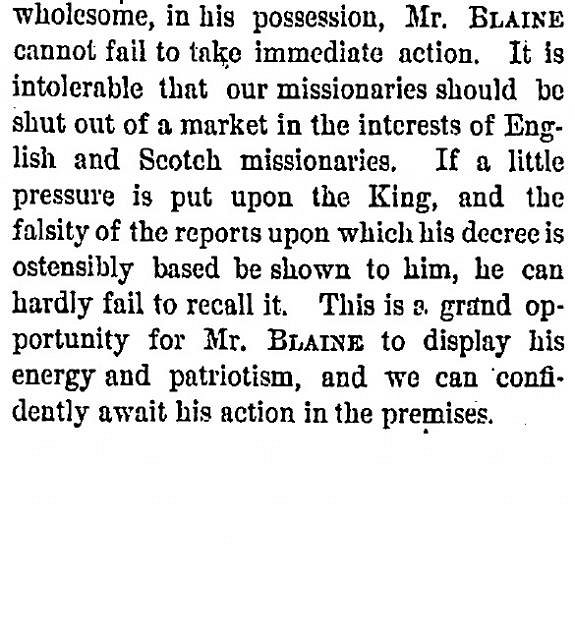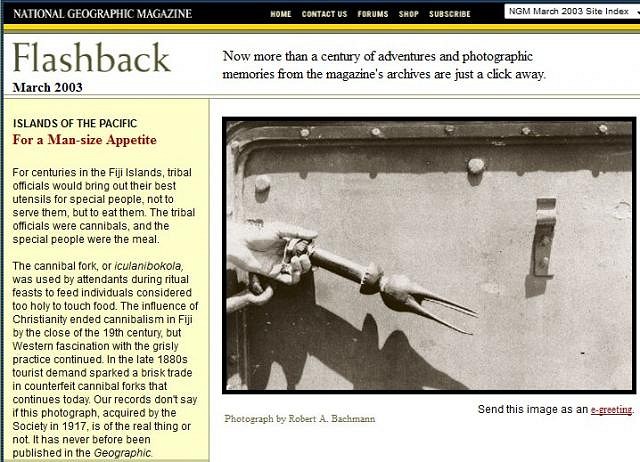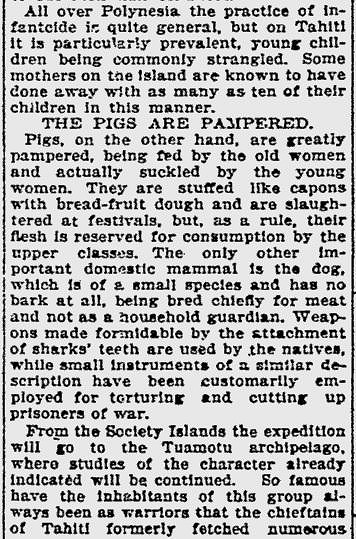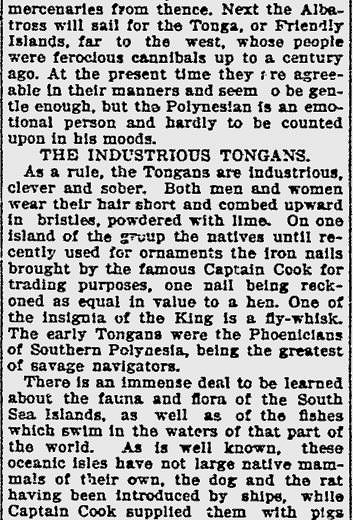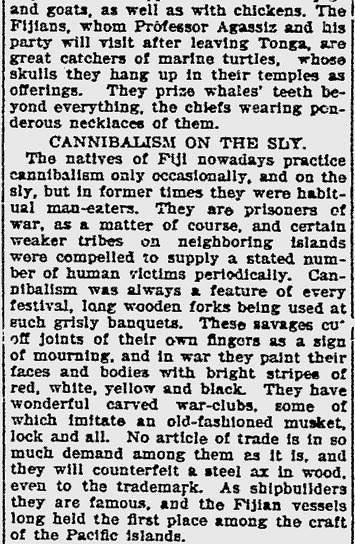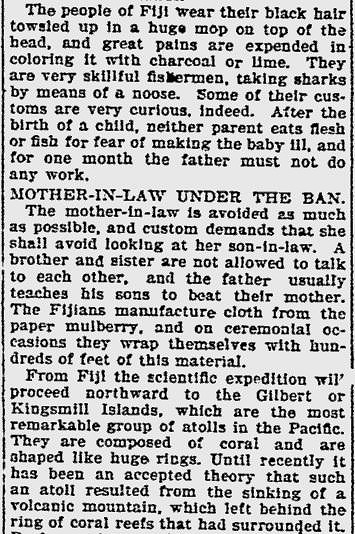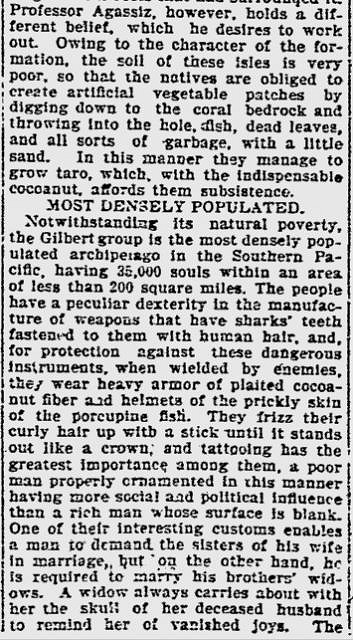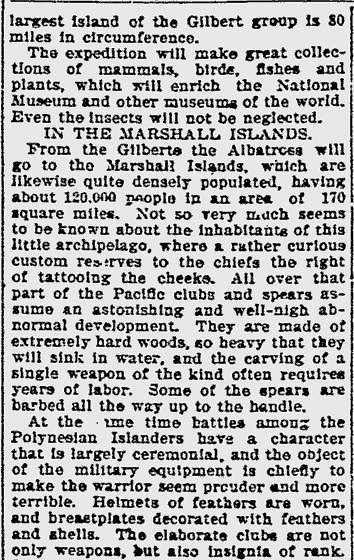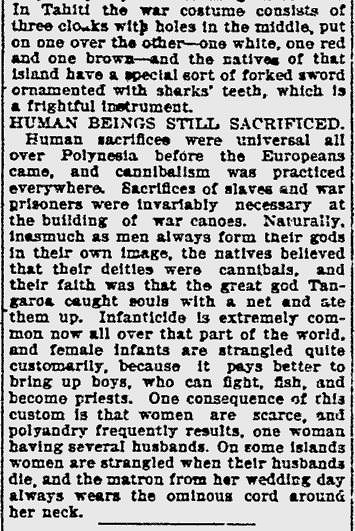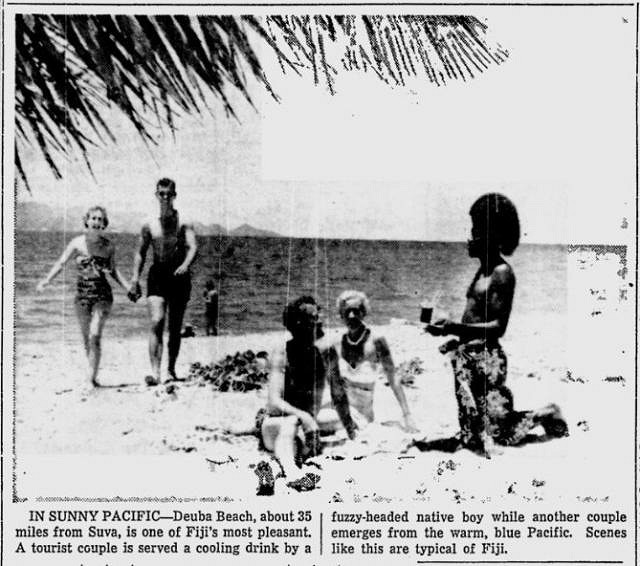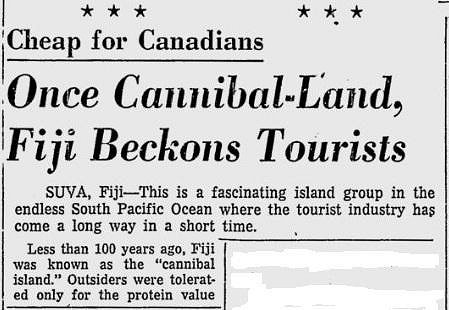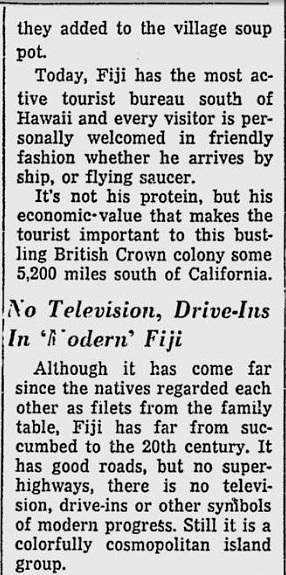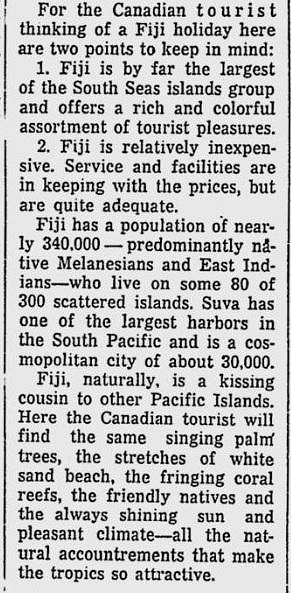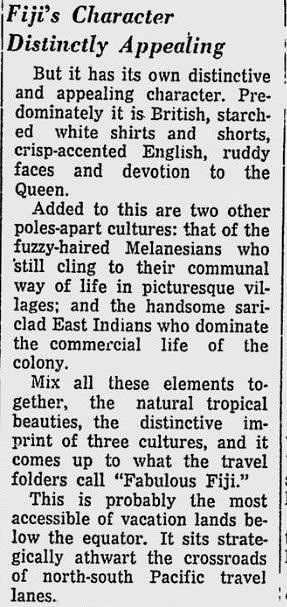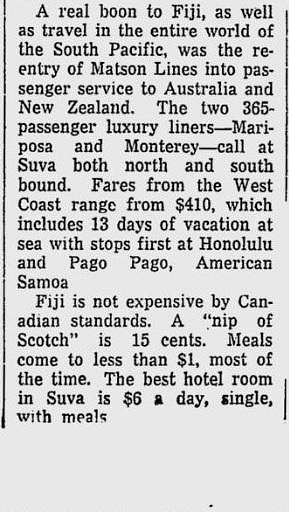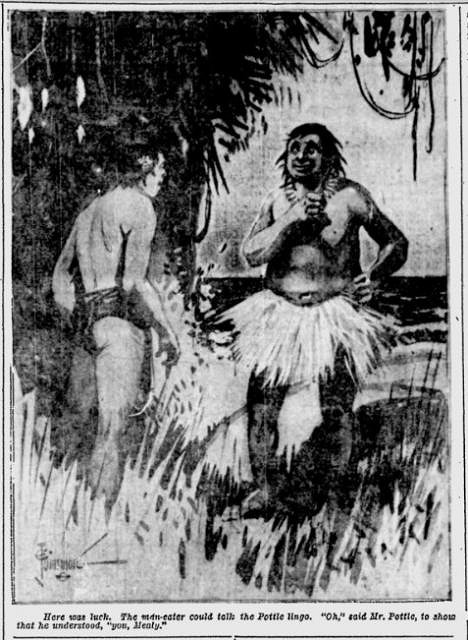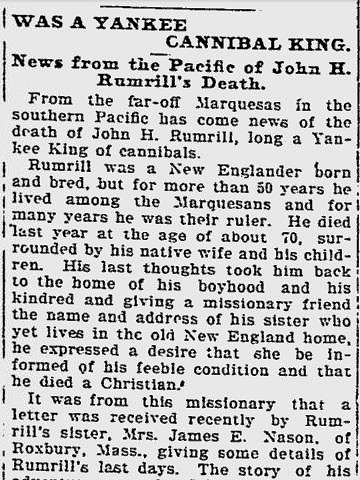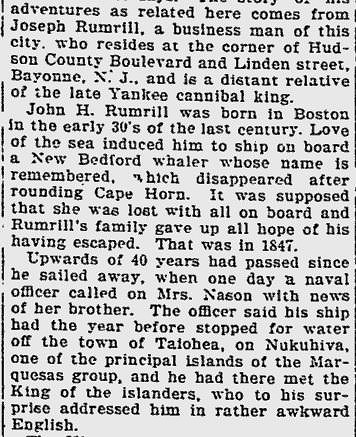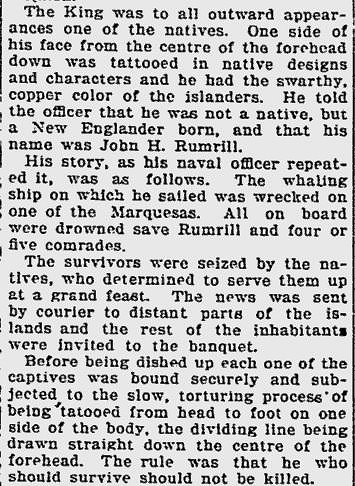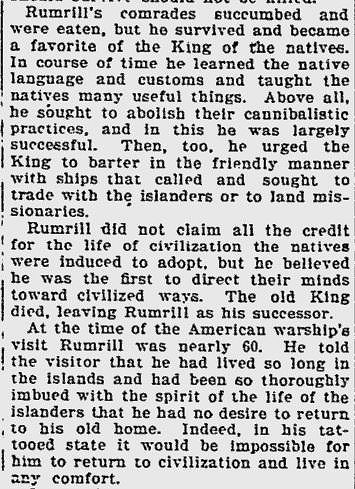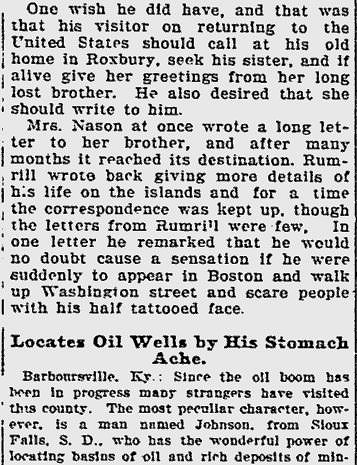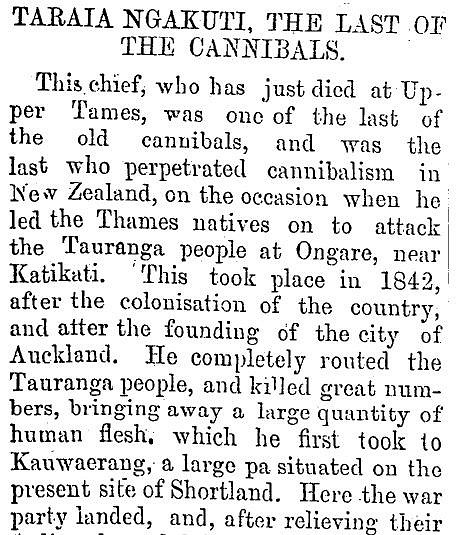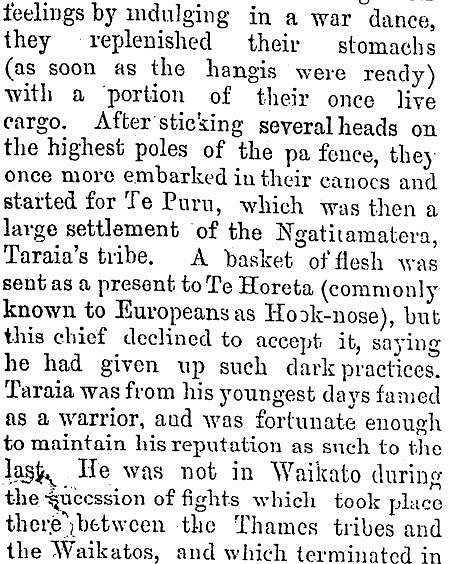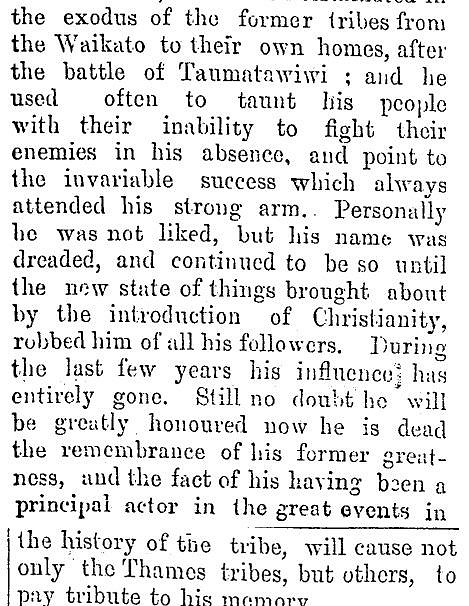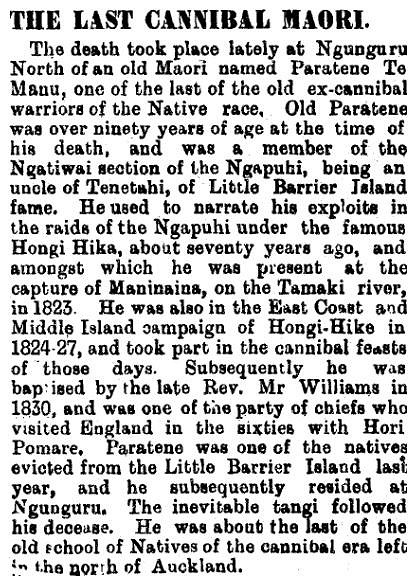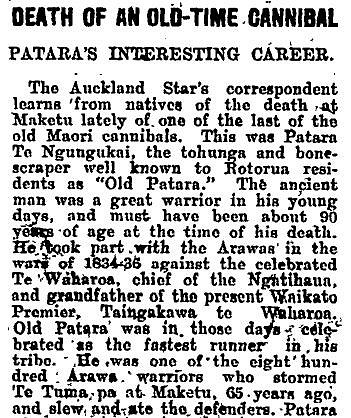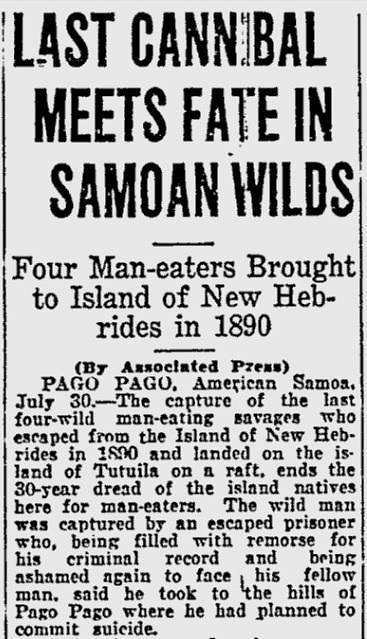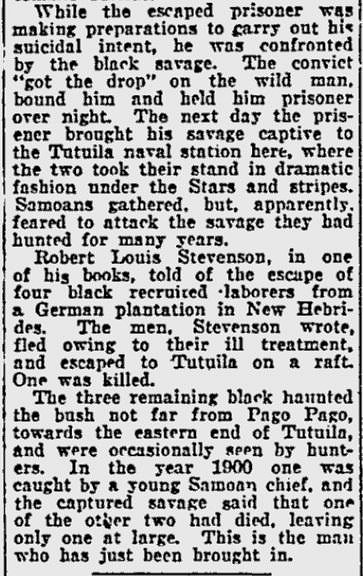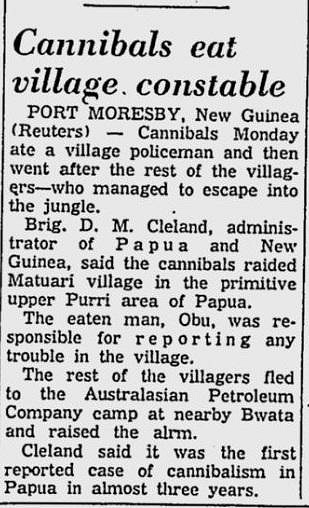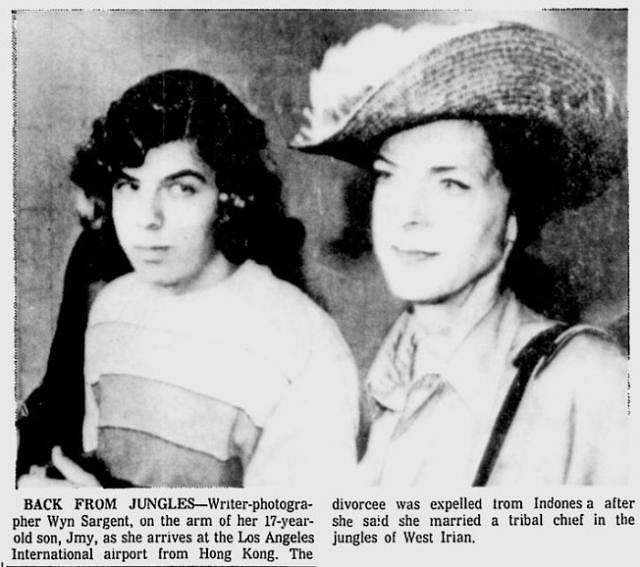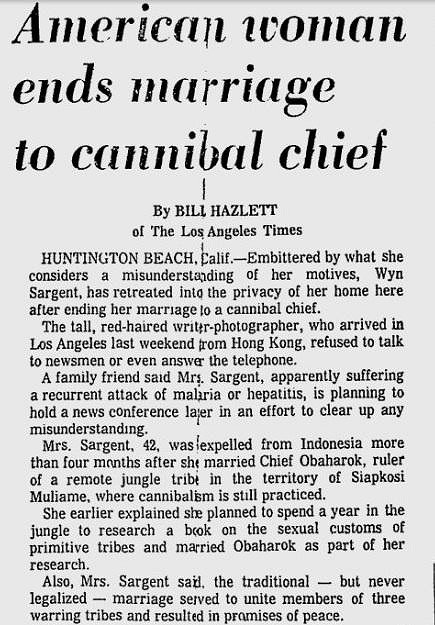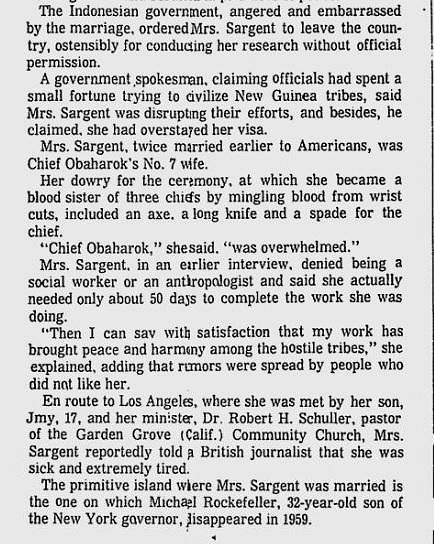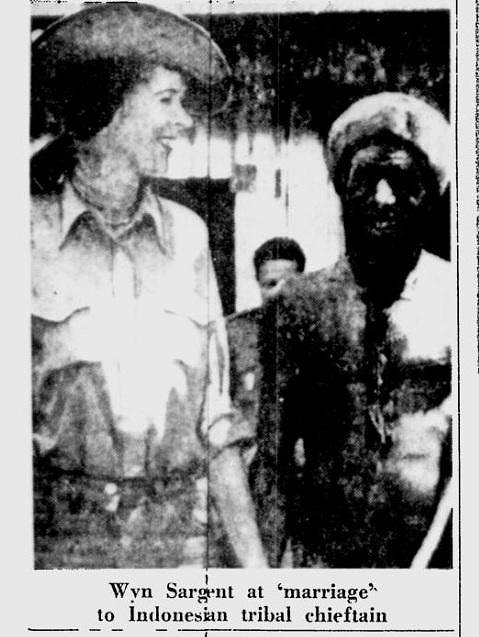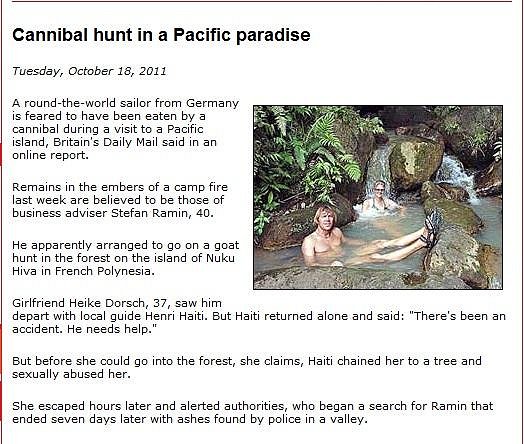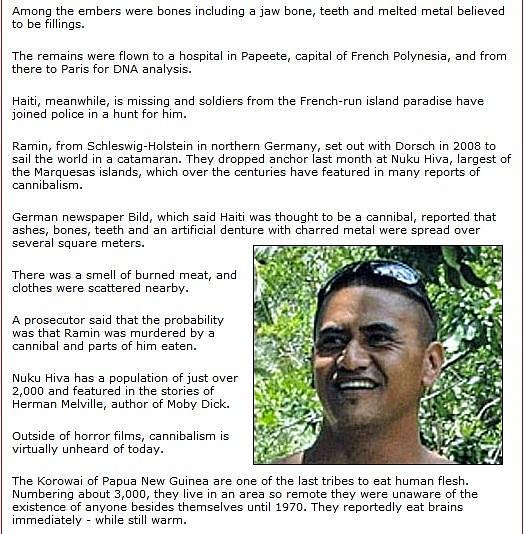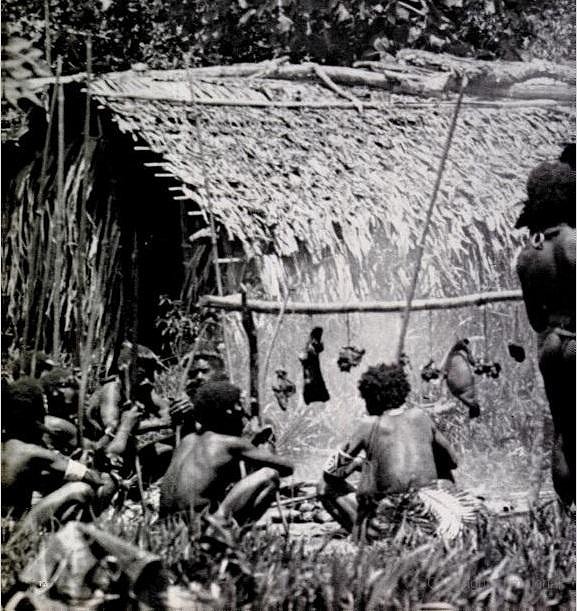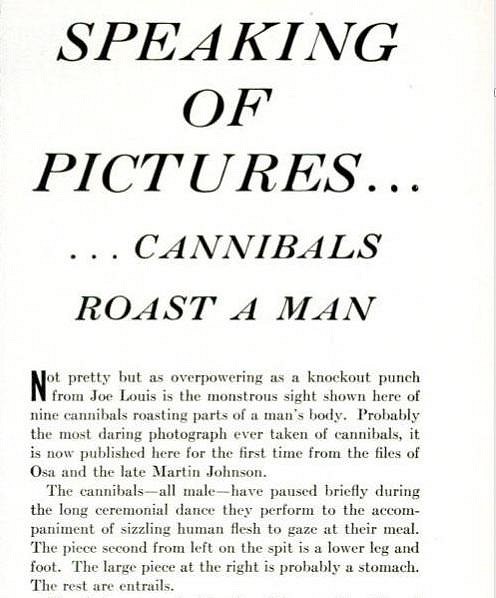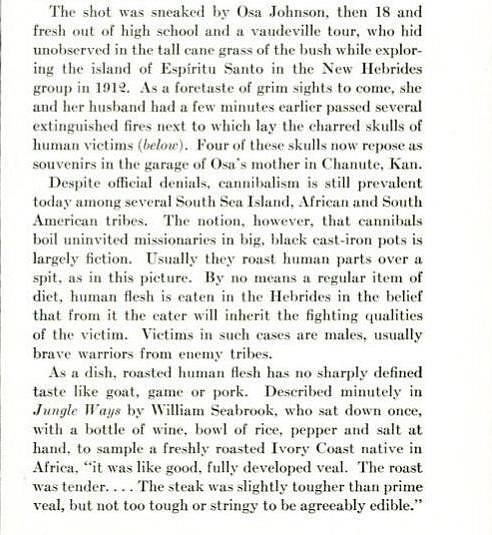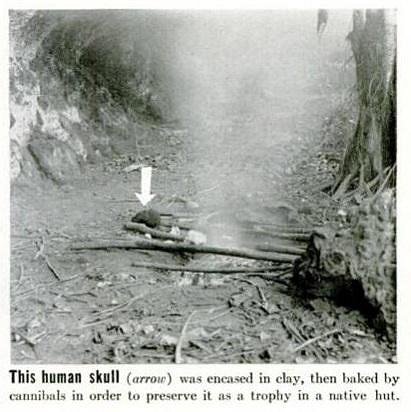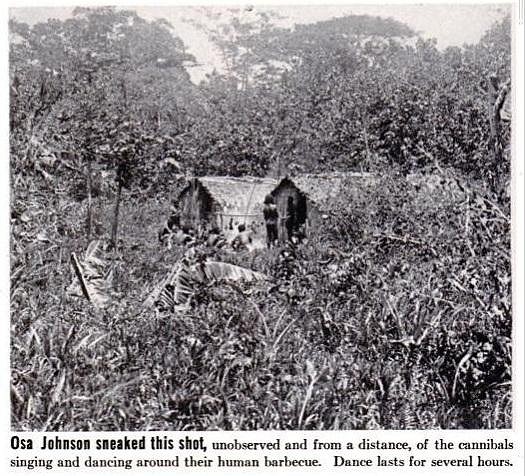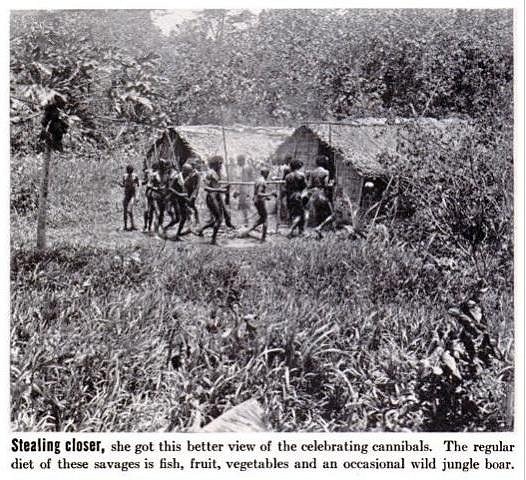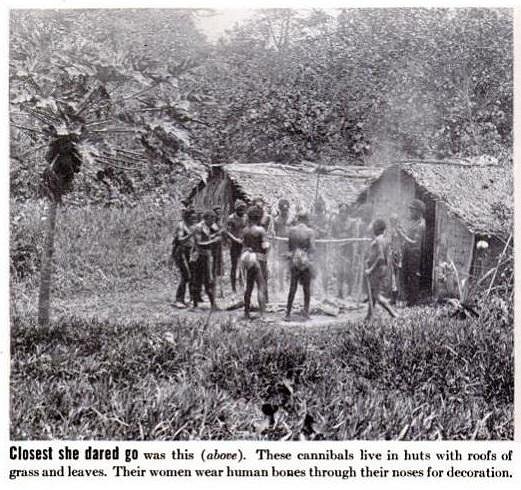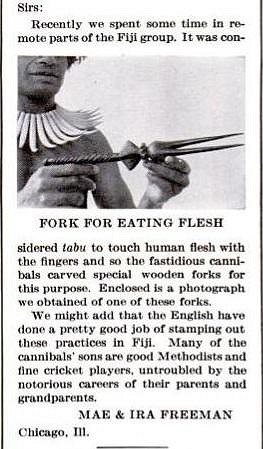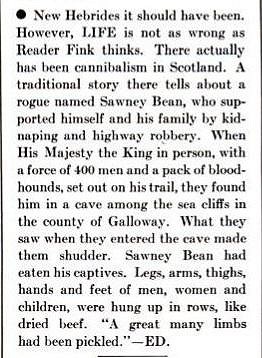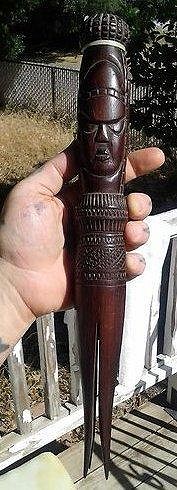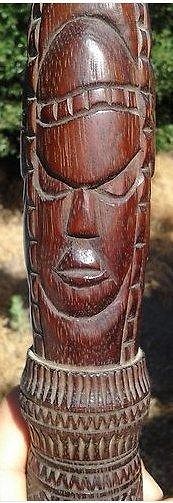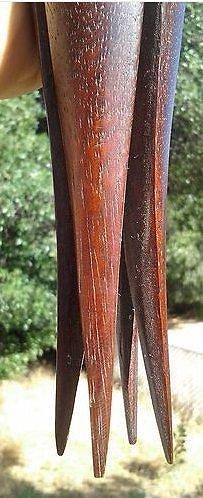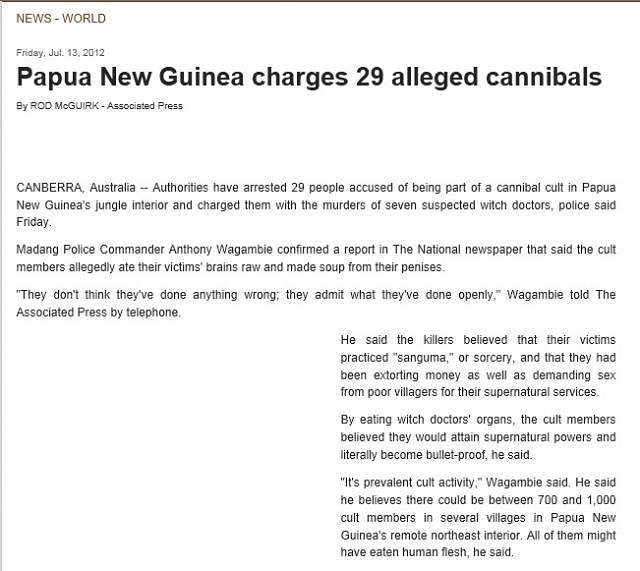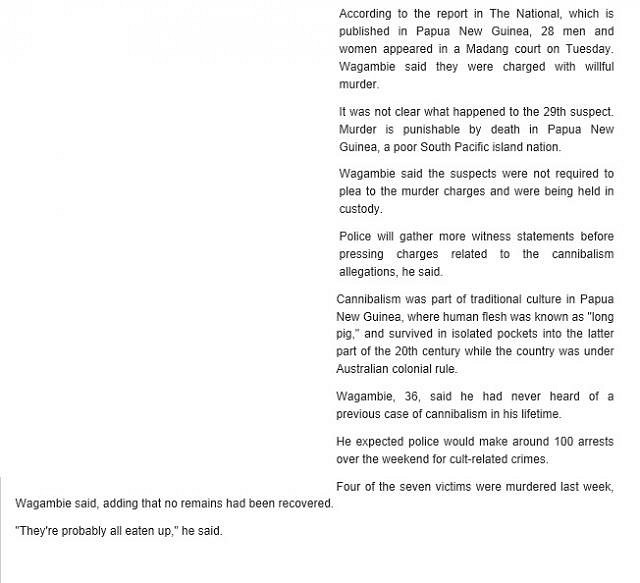Beyond Tiki, Bilge, and Test / Beyond Tiki
Cannibals were picky eaters?
Pages: 1 23 replies
|
T

TikiTomD
Posted
posted
on
Fri, Dec 30, 2011 1:13 PM
From the Google News archives 25 years ago comes this article asserting that Christian missionaries were rarely an impulse snack... The Free Lance-Star November 5, 1986 (page 12) You might find the Reverend Mr. Brown a bit skeptical of the prior article’s conclusions, according to this 128-year old article from the National Library of New Zealand archives... Otago Daily Times March 31, 1883 -Tom |
|
M
MadDogMike
Posted
posted
on
Fri, Dec 30, 2011 1:28 PM
"I hold that it is not a missionary's duty to be eaten until he has expended his last cartridge" That's rich! |
|
K
komohana
Posted
posted
on
Fri, Dec 30, 2011 5:44 PM
culturally sensitive to some but an extremely interesting topic none the less, |
|
V
VampiressRN
Posted
posted
on
Sat, Dec 31, 2011 1:36 AM
Gruesome visions in my head from reading those articles, but very interesting. I guess getting a good BBQ recipe is out of the question? |
|
T

TikiTomD
Posted
posted
on
Sat, Dec 31, 2011 7:01 AM
MDM, that article is rich throughout. It clearly underscores that the missionaries were, unwitting or not, sort of the special forces of the colonial nations, landing on remote beach heads in what could be a suicide mission to collect intel and “civilize” the indigenous peoples, preparing them for later settlement and exploitation by the colonial powers and their merchants. This is clearly a sensitive subject all around. There were many selfless clerics who, in addition to fulfilling their holy calling, gave their all in trying to serve and protect the native peoples from the colonial tidal wave that inevitably followed them. Komohana, only TC Moderators have the power to move threads among forums. This thread could go either way, up to General Tiki or downward to Bilge, depending on the responses and desires of the Ohana. I tried to strike a balance, as the subject is serious and clearly plays in Poly pop iconography. But in dealing with its serious nature, folks will naturally lighten the topic up a bit. I’m not immune to that myself. So, VampiressRN, you’re wondering if there is a cannibal’s version of Louis Spievak’s Barbecue Chef, perhaps a Bobby Flay recipe for grilling puaka `enata, literally Marquesan for “pig people” but roughly translated as long pig... with parental controls alarming, the search engine did come up with this recipe for Kalua Long Pig. Don’t overlook the oiling and massaging :) In the following article, Lord Shackleton insists that cannibals are discerning, even health conscious eaters... The Age March 22, 1963 (page 3) Here’s a 64-year old article from the Google News archives with a little-known story involving Abraham Lincoln and Marquesan cannibals... Sarasota Herald-Tribune February 12, 1948 (page 13) -Tom |
|
T

TikiTomD
Posted
posted
on
Sat, Dec 31, 2011 1:07 PM
Lord Shackleton was apparently correct, as this article from more than 130 years ago indicates a belief that American missionaries were unhealthy to consume for one reason or another in The Cannibal Islands (now know as Fiji), and there was a marked preference for British missionaries... The New York Times April 11, 1881 -Tom |
|
V
VampiressRN
Posted
posted
on
Sat, Dec 31, 2011 2:30 PM
Once again eerie but fascinating. The utensils are unique too!!!
|
|
K
komohana
Posted
posted
on
Sat, Dec 31, 2011 8:33 PM
A very serious topic indeed, and to take the focus off the pacific island nations for a moment, For example, various parties here in Australia have sought to gain political milage from tales of There are literally days of reading to wade through so i'll just post a few links and anyone interested http://www.warriors.egympie.com.au/cannibalism.html ...and an exceptionally interesting article here; http://sydney.edu.au/law/slr/slr27_4/Biber.pdf Tales of cannibalism among early seafarers are also nothing new, with established traditions dating back http://en.wikipedia.org/wiki/Custom_of_the_Sea Also worth a look for anyone who hasn't seen it yet, is the film "Van Diemens Land", the incredibly |
|
M
MadDogMike
Posted
posted
on
Sun, Jan 1, 2012 8:18 AM
Tom, that 1881 New York Times article is hilarious - it seems to be written a bit "tongue in cheek", satire is something we are not used to seeing in our newspapers today except in the editorial cartoons. |
|
T

TikiTomD
Posted
posted
on
Sun, Jan 1, 2012 11:47 AM
VampiressRN, if I ever get to Fiji and see that implement brought out, I’ll know what (or rather who) is for dinner. Mahalo, komohana, for all of the interesting, if grisly, reading material on the subject, all of it new to me. Your point is well taken; cannibalism was not limited to any particular region of the world. In fact, the word itself originated from my part of the world, in the West Indies, according to this reference article in scribd.com...
Mike, that was most certainly a bit of 19th century political satire, but it sure fit in with the topic! Since VampiressRN introduced us to the subject of cannibal forks, here is a related article from more than 100 years ago that really shows its cultural bias... oh, those sly cannibal Fijians... The Reading Eagle July 1, 1899 (page 3) As cannibalism evolved to tourism, we have this report, again where the cultural lens of the times is so evident... The Windsor Daily Star December 22, 1956 (page 14) And from the Google News archive, we have this 1922 fictional tale by Richard Connell of an Ohio barber who fantasizes a South Seas adventure, then decides to make it real, “Mr. Potter and the South Sea Cannibals”(page 30)...
-Tom |
|
T

TikiTomD
Posted
posted
on
Mon, Jan 2, 2012 8:33 AM
An interesting tale of a Yankee cannibal king; later reports suggest that this story was not wholly accurate; for example, Rumrill was not shipwrecked but deserted... The Reading Eagle July 6, 1902 (page 9) So, when and where was the last cannibal? From various regions, here are a sampling of reports from the National Library of New Zealand and Google News archives... Wanganui Herald March 25, 1872 Ashburton Guardian January 16, 1897 Wanganui Herald June 15, 1901 The Miami News-Metropolis July 28, 1923 (page 15) In some parts of the world, old ways may remain (though not cited, that may also include remote areas of South America and Africa)... The Leader-Post May 19, 1959 The Windsor Star February 20, 1973 (page 12) The Standard October 18, 2011 -Tom [ Edited by: TikiTomD 2012-01-03 03:03 ] |
|
V
VampiressRN
Posted
posted
on
Mon, Jan 2, 2012 9:38 PM
YIKES...that is some scary reading. Fascinating but scary!!! |
|
K
komohana
Posted
posted
on
Sat, Feb 18, 2012 3:17 AM
An extremely interesting example of this is the incredible but true saga befalling the hapless crew of the A first-hand account of the tragedy, by the first mate Owen Chase, can be found here: |
|
T

TikiTomD
Posted
posted
on
Sun, Feb 26, 2012 1:57 PM
Bob, I finally got a chance to read the entire story of the Essex... that was as dreadful a tale of privation as any I've come across. In the case of the Essex, the cannibals weren't picky eaters, as survival rather than ritual was the motivation. Interesting, too, this tale's role in the genesis of Melville's Moby Dick. *** WARNING *** This thread isn't really good fare for those with delicate sensibilities. That is especially true for the material that follows, which contains graphic images of a cannibal luau in preparation. From a March 25, 1940 article in Life Magazine...
Letters to the editor on the article appeared in the April 15, 1940 issue of Life Magazine...
-Tom |
|
K
komohana
Posted
posted
on
Sun, Feb 26, 2012 6:15 PM
Aloha Tom, fascinating material as always. Yes, the tale of the Essex - probably the quintessential account of its type - was indeed the Anyhow, to my mind, one of the most interesting aspects of the story regarding the Essex If only they had struck for Tahiti, they might have whiled-away their time in paradise. [ Edited by: komohana 2012-02-26 23:09 ] |
|
V
VampiressRN
Posted
posted
on
Sun, Mar 25, 2012 12:19 PM
I know some folks are not appreciative of Wikipedia, but I think there is decent information on many topics. This is just a snippet from there on Cannibalism. |
|
KBT3

King Bushwich the 33rd
Posted
posted
on
Sun, Mar 25, 2012 12:42 PM
Breaking news.... So which thread becomes the official cannibal thread of Tiki Central? If we're not supposed to eat people, why are they made out of meat? [->>King Bushwich 33rd on Hulu.com |
|
I
ikitnrev
Posted
posted
on
Sun, Mar 25, 2012 1:11 PM
(This message was first posted two weeks ago in another thread - I am relocating to this thread, as it is a much better fit here) A new book on cannibalism.... 'An Intellectual History of Cannibalism' by Catalin Avramescu I have not yet purchased or read the book, but the above book review provides some insight into the theological debates raised by the Church and missionaries when encountering civilization where people were eaten. Here is a sample .....A starving man eats the flesh of another, whereupon the flesh of the eaten is transformed into that of the eater. At the Resurrection, how will the bodies of each be made whole and rise up entire? If this problem could not be satisfactorily addressed, one Church Father wrote, critics could rightly “draw the conclusion that the resurrection cannot take place, because it is not possible for two men to be resurrected with the same flesh at the same time.” |
|
V
VampiressRN
Posted
posted
on
Sun, Mar 25, 2012 2:00 PM
Obviously the Admins may need to help corral all the Cannibal posts in one thread. At least we know the topic doesn't require a forum. :lol: It is a creepy subject but hauntingly interesting. At least when I am shuffling through a bin of wooden trinkets and come across a fork, I will know what it is. Might be worth a small fortune and look good on the dining table. :wink: |
|
V
VampiressRN
Posted
posted
on
Sat, Jul 21, 2012 6:55 PM
OK...there I was mindlessly shopping on Amazon and also checking out ridiculous things on eBay and I never expected to find a cannibal fork for sale, but there it was on evilbay. Not Tiki as it is apparently from Africa...probably a TCer downsizing...but damnit...I just had to have it. I am a dish collector, but don't think I will be adding more to this acquisition to complete a service for 8. Here are some pics.
|
|
T

TikiTomD
Posted
posted
on
Sun, Jul 22, 2012 6:18 AM
Wow, Marlene, that’s some fork! Maybe you can place that on the table setting when you next have some Tiki friends over to your home, and observe their reactions as they contemplate whether you’re serving the other white meat :) The news media continues to ply our macabre fascination of the subject with a surprising number of contemporary Hannibal Lecter stories, though the involved individuals generally lack the brilliance of mind associated with that fictional character. It seems that there is no shortage of actual monsters in the “developed” world. Meanwhile, back in the jungle, some things remain a bit “traditional”... Myrtle Beach Online July 13, 2012 -Tom |
|
V
VampiressRN
Posted
posted
on
Sun, Jul 22, 2012 8:42 AM
YIKES!!! That is scary. |
|
T
tikilongbeach
Posted
posted
on
Tue, Jan 6, 2015 2:36 PM
Ron Howard has directed a movie about the ill fated Essex whaling ship that inspired Melville to write Moby Dick. "In the Heart of the Sea" stars Chris Hemsworth and it will be released on March 13, 2015. This Smithsonian article about the Essex is pretty graphic. http://www.smithsonianmag.com/history/the-true-life-horror-that-inspired-moby-dick-17576/ "The men were unwilling to leave the doomed Essex as it slowly foundered, and Pollard tried to come up with a plan. In all, there were three boats and 20 men. They calculated that the closest land was the Marquesas Islands and the Society Islands, and Pollard wanted to set off for them—but in one of the most ironic decisions in nautical history, Chase and the crew convinced him that those islands were peopled with cannibals and that the crew’s best chance for survival would be to sail south. The distance to land would be far greater, but they might catch the trade winds or be spotted by another whaling ship. Only Pollard seemed to understand the implications of steering clear of the islands. (According to Nathaniel Philbrick, in his book In the Heart of the Sea: The Tragedy of the Whaleship Essex, although rumors of cannibalism persisted, traders had been visiting the islands without incident.)" |
|
T
TikiHardBop
Posted
posted
on
Wed, Jan 7, 2015 3:35 PM
The book was extraordinary. It looks like the movie is going to be an action-packed roller coaster, which means it will bear scant resemblance to the real story! |
Pages: 1 23 replies


